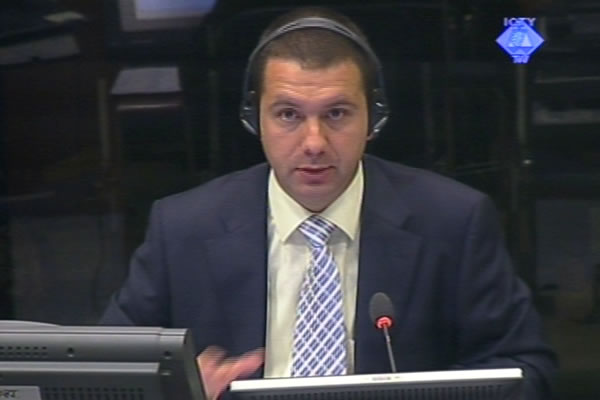Home
UPDATED INFORMATION ABOUT SREBRENICA MASS GRAVES
At the trial of Radovan Karadzic, former OTP investigator Dusan Janc presented an updated report on the results of the investigation of Srebrenica mass graves. In the first part of the cross-examination, Karadzic claimed that the witness ‘took for granted’ the results of the international experts’ work
 Dusan Janc, witness at the Radovan Karadzic trial
Dusan Janc, witness at the Radovan Karadzic trial The trial of Radovan Karadzic continued with the evidence of Slovenian police inspector Dusan Janc. From 2006 to 2009, he worked as an investigator for the OTP. He was involved in the investigation of Srebrenica mass graves and the identification of exhumed victims. The witness consolidated the findings of the international expert team in the reports that were exhibited at several of the Tribunal’s trials for genocide in Srebrenica. Janc prepared a similar report for the trial of Radovan Karadzic.
In the examination-in chief, Janc defined the four main goals of his latest report from December 2011 and January 2012: updating the figures for the victims identified to date, presenting the new locations where mass graves were found, presenting facts related to the remains found on the ground surface, and finally, noting the established links between mass graves and execution sites and between primary and secondary mass graves.
Summarizing the data on the number of victims, the witness noted that approximately the same number of persons were killed at three sites: 815 persons were executed at the Branjevo farm, 841 persons in Orahovac, and 815 victims in Kozluk. According to Janc, this shows that the Serb army had at its disposal the number of vehicles sufficient to transport that many of prisoners to a site. The witness was shown a VRS document dated 13 July 1995, in which Zdravko Tolimir reports to Milan Gvero that a site where about 800 prisoners could be put up was found in Sjemec. This area was investigated and it was established that the prisoners never arrived there, the witness explained. The prisoners were never taken to a prison camp, but to an execution site, it was later determined.
In the first part of the cross-examination Karadzic put it to Janc that he ‘took for granted’ the data from the reports made by the international experts who were involved in the exhumations of the mass graves and the effort to identify the victims. One of the international experts was forensic anthropologist William Haglund, whose work, the accused pointed, was criticized at one point. Janc explained that he didn’t pursue a more detailed investigation of the criticism against Haglund because he had at his disposal other evidence on the crimes in Srebrenica. Janc said he was ready to answer more specific questions about any mistakes the Srebrenica investigation team may have made, but Karadzic then moved to another topic, remarking he would deal with the issue if he had enough time.
Karadzic asked the witness what made him believe that the exhumed remains were those of people killed after the fall of the Srebrenica enclave, and not months or years before that event. All established facts should be taken into consideration: the findings about the cause of death, the locations where the victims were found, the artifacts recovered from the mass graves, aerial photos showing the area before and after primary graves were dug up and the bodies were moved to new locations, the statements of those who survived the executions and those who took part in them, numerous VRS documents and other evidence, the witness replied.
Karadzic asked the witness why the bodies had been moved from primary to secondary graves. In Janc’s opinion, this was done to ‘hide’ the bodies ‘from someone’ and to destroy the evidence of the crimes.
Karadzic will continue his cross-examination of Dusan Janc on Wednesday, 28 March 2012.
Linked Reports
- Case : Karadzic
- 2012-03-26 HORRIFIC SCENES FROM SREBRENICA
- 2012-03-23 KARADZIC AND ‘TALL TALES’ FROM SREBRENICA
- 2012-03-22 KARADZIC’S ‘NEW INFORMATION’ ON THE NUMBER OF SREBRENICA VICTIMS
- 2012-03-28 WITNESS: THERE WAS NO CLEAN-UP
- 2012-03-29 REIGN OF FEAR IN ZVORNIK
- 2012-03-30 KARADZIC WANTS TO CALL STAKIC AS HIS DEFENSE WITNESS
